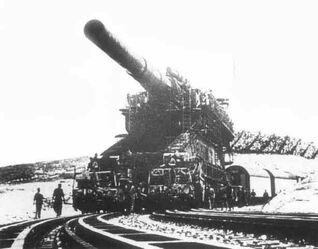
Front View of the Schwerer Gustav
Schwerer Gustav and Dora were the names of two massive World War II German 80 cm K (E) railway siege guns. They were developed in the late 1930s by Krupp for the express purpose of destroying heavy fortifications, specifically those in the French Maginot Line. They weighed nearly 1,350 tonnes, and could fire shells weighing seven tonnes to a range of 47 kilometers (29 mi). Designed in preparation for World War II, and intended for use against the deep forts of the Maginot Line, they were not ready for action when the Wehrmacht outflanked the line during the Battle of France. Gustav was used in the Soviet Union at the siege of Sevastopol during Operation Barbarossa. They were moved to Leningrad, and may have been intended for Warsaw. Gustav was captured by US troops and cut up, whilst Dora was destroyed near the end of the war to avoid capture by the Red Army.
It was the largest-calibre rifled weapon ever used in combat and fired the heaviest shells of any artillery piece. It is only surpassed in calibre by the British Mallet's Mortar (36 inch; 914 mm) and the American Little David mortar (36 inch; 914 mm).
In 1934 the German Army High Command (OKH) commissioned Krupp of Essen, Germany to design a gun to destroy the forts of the French Maginot Line which were then nearing completion. The gun's shells had to punch through seven meters of reinforced concrete or one full meter of steel armour plate, from beyond the range of French artillery. Krupp engineer Erich Müller calculated that the task would require a weapon with a calibre of around 80 cm, firing a projectile weighing 7 tonnes from a barrel 30 meters long. The weapon would have a weight of over 1000 tonnes. The size and weight meant that to be at all movable it would need to be supported on twin sets of railway tracks. In common with smaller railway guns, the only barrel movement on the mount itself would be elevation, traverse being managed by moving the weapon along a curved section of railway line. Krupp prepared plans for calibres of 70 cm, 80 cm, 85 cm, and 1 m.Nothing further happened until March 1936 when, during a visit to Essen, Adolf Hitler enquired as to the giant guns' feasibility. No definite commitment was given by Hitler, but design work began on an 80 cm model. The resulting plans were completed in early 1937 and approved. Fabrication of the first gun started in the summer of 1937. However, technical complications in the forging of such massive pieces of steel made it apparent that the original completion date of spring 1940 could not be met.
Krupp built a test model in late 1939 and sent it to the Hillersleben firing range for testing. Penetration was tested on this occasion. Firing at high elevation, the 7.1 tonne shell was able to penetrate the specified seven meters of concrete and the one meter armour plate.[3] When the tests were completed in mid-1940 the complex carriage was further developed. Alfried Krupp, after whose father the gun was named, personally hosted Hitler at the Rügenwald Proving Ground during the formal acceptance trials of the Gustav Gun in the spring of 1941. Hitler was so awestruck that he commanded that the 11-tonne[citation needed] shell could only be used at his discretion. As he never gave permission, it was never deployed.An 800 mm shell next to a Soviet T-34-85 tank at the Imperial War Museum, London
Two guns were ordered. The first round was test-fired from the commissioned gun barrel on 10 September 1941 from a makeshift gun carriage on the Hillersleben firing range. In November 1941 the barrel was taken to Rügenwald, where 8 further firing tests were carried out using the 7,100 kilogram armor-piercing (AP) shell out to a range of 37,210 meters.In combat, the gun was mounted on a specially designed chassis, supported by eight bogies on two parallel sets of railway tracks. Each of the bogies had 5 axles, giving a total of 40 axles (80 wheels). Krupp christened the gun Schwerer Gustav (Heavy Gustav) after the senior director of the firm, Gustav Krupp von Bohlen und Halbach.The gun could fire a heavy concrete-piercing shell and a less heavy high-explosive shell. A super-long-range rocket projectile was also planned with a range of 150 km, that would require the barrel being extended to 84 meters.In keeping with the tradition of the Krupp company, no payment was asked for the first gun. However, they did charge seven million Reichsmark for the second gun Dora, named after the senior engineer's wife.
In February 1942, Heavy Artillery Unit 672 reorganized and went on the march, and Schwerer Gustav began its long ride to the Crimea. The train carrying the gun was of 25 cars, a total length of 1.5 kilometers. The gun reached the Perekop Isthmus in early March 1942, where it was held until early April. A special railway spur line was built to the Simferopol-Sevastopol railway 16 kilometers (9.9 mi) north of the target, at the end of which four semi-circular tracks were built specially for the Gustav to traverse. Outer tracks were required for the cranes which would have assembled Gustav.The siege of Sevastopol was to be the gun's first combat test. Installation began in early May, and by 5 June the gun was ready to fire.